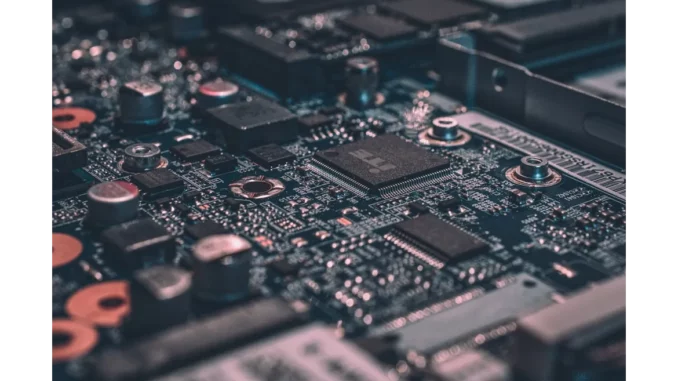
Summary
Emerging Semiconductor Technologies Signal Industry Evolution
In a comprehensive interview with Dr. Elara Voss, a prominent researcher in semiconductor technology, critical developments in the field were highlighted. The conversation centred on the top 10 emerging semiconductor technologies, showcasing their transformative potential across industries. “The semiconductor industry is at the forefront of technological evolution,” Dr. Voss stated, emphasising the significant impact of these advancements on efficiency, sustainability, and innovation.
Main Article
3D Printing: A Customisation Revolution
The integration of 3D printing in the semiconductor industry marks a significant shift from mere prototyping to precise customisation of components. Dr. Voss illuminated this progression: “It’s about creating tailored semiconductor components with unmatched precision.” This technology is particularly beneficial in crafting intricate heatsinks and bespoke packaging solutions, enhancing efficiency and functionality. Noteworthy in this arena is Syenta, a startup pioneering an electrochemistry-based process that simplifies manufacturing while minimising environmental impact.
Artificial Intelligence and Enhanced Precision
Artificial Intelligence (AI) has become a critical tool in refining semiconductor processes, particularly in chip design and quality control. Dr. Voss elaborated on AI’s transformative role: “AI algorithms predict equipment failures, significantly reducing downtime.” BFAI Semiconductor Solutions exemplifies innovation in this field, offering AI-driven modules for quality control and process optimisation, thereby enhancing overall manufacturing efficiency.
AR and VR: Redefining Training and Collaboration
The deployment of Augmented Reality (AR) and Virtual Reality (VR) in semiconductor manufacturing is revolutionising training and collaboration. “AR and VR are reshaping how we approach manufacturing,” Dr. Voss noted. These technologies enable immersive training experiences and facilitate remote collaboration, reducing errors and improving operational efficiency. Lavorro, a startup in this domain, provides AR solutions that foster real-time problem-solving, thus boosting productivity in semiconductor fabs.
Big Data and Advanced Analytics
The application of big data analytics in semiconductor manufacturing allows for informed decision-making by extracting actionable insights from extensive datasets. “Data analytics is key in identifying bottlenecks and optimising yield,” Dr. Voss pointed out. Innowave Tech stands out with its AI-enhanced factory solutions, which deliver insights for zero-defect maintenance and process refinement.
Advancements in Material Science
The exploration of advanced materials such as graphene and silicon carbide is expanding the capabilities of semiconductors. Dr. Voss explained the advantages: “These materials offer superior electrical conductivity and thermal properties.” Black Semiconductor is at the forefront of this innovation, creating chips that integrate electronics and photonics for enhanced performance and reduced energy consumption.
Commitment to Sustainable Practices
Sustainability is increasingly becoming a priority in semiconductor manufacturing. Dr. Voss emphasised efforts to lessen environmental impact through water conservation and energy-efficient processes. Purity Resource exemplifies this commitment, specialising in recycling isopropanol for reuse, thus promoting sustainability within the industry.
Connectivity and IoT Integration
Emerging connectivity technologies, notably 5G and the Internet of Things (IoT), are vital for real-time data transfer and smart logistics in semiconductor manufacturing. “These technologies ensure seamless communication and efficiency,” Dr. Voss shared. Packetcraft, a startup innovating in this space, offers Bluetooth solutions for low-power communication in embedded systems, highlighting the importance of connectivity.
Automation and Efficiency
Automation continues to play a crucial role in modern semiconductor fabs, enhancing efficiency and maintaining clean environments. Dr. Voss noted, “Automation reduces contamination risks and boosts throughput.” Revolution EDA, a startup in this sector, provides open-source design automation software that streamlines integrated circuit design workflows.
Nanotechnology: Maximising Potential
Nanotechnology is advancing the miniaturisation and efficiency of semiconductor devices. “Smaller, more efficient devices are within reach,” Dr. Voss remarked. Aeluma, a standout startup, is integrating semiconductor nanomaterials with scalable silicon-based processes for optoelectronic devices, expanding applications in AI and augmented reality.
Detailed Analysis
The semiconductor industry is undergoing a profound transformation driven by these emerging technologies. The integration of AI, AR, and VR is enhancing precision and collaboration, while advanced materials and nanotechnology are redefining device capabilities. Meanwhile, sustainability efforts reflect broader economic trends towards environmentally conscious manufacturing. The evolution of connectivity technologies underscores the growing need for seamless integration across digital ecosystems.
Further Development
As the semiconductor landscape evolves, continued advancements and challenges lie ahead. Stakeholders are closely monitoring how these technologies will influence market dynamics and competitiveness. Future articles will delve deeper into the implications of these trends on global supply chains and economic policies, inviting readers to stay informed and engaged with the unfolding narrative.

